Microstructure and Chlorine Ion Corrosion Performance in Bronze Earring Relics
Abstract
:1. Introduction
2. Materials and Methods
2.1. Materials
2.2. Methods
3. Results and Discussion
3.1. Structure and Composition
3.2. Corrosion Products
3.3. Electrochemical Corrosion Characteristics
4. Conclusions
Author Contributions
Funding
Institutional Review Board Statement
Informed Consent Statement
Data Availability Statement
Acknowledgments
Conflicts of Interest
References
- Wu, Z.; Zhu, Z.; Wu, R. Thermodynamic analysis of nanocrystalline solid solutions formation in copper-lead-tin ternary immiscible system during mechanical alloying. Mater. Werkst. 2021, 52, 1328–1337. [Google Scholar] [CrossRef]
- Chang, T.; Herting, G.; Goidanich, S.; Amaya, J.S.; Arenas, M.; Le Bozec, N.; Jin, Y.; Leygraf, C.; Wallinder, I.O. The role of Sn on the long-term atmospheric corrosion of binary Cu-Sn bronze alloys in architecture. Corros. Sci. 2019, 149, 54–67. [Google Scholar] [CrossRef]
- Dong, B.; Jie, J.; Peng, B.; Qu, J.; Wu, Z.; Wang, Q.; Zhou, J.; Liu, S.; Zou, Q.; Wang, T. Revealing the Relationship between Morphology of Pb-Rich Secondary Phases and Mechanical Properties of Laminated Cu–Pb–Sn/Steel Composite Through CALPHAD and FEA. Metall. Mater. Trans. A 2022, 53, 1462–1478. [Google Scholar] [CrossRef]
- Cao, J.; Sun, J. 21st-Century Archaeological Discoveries of the Early Nomadic Cultural Remains–Centered in the Middle Section of the Great Wall Area in Inner Mongolia Autonomous Region. J. Sib. Fed. Univ. 2021, 14, 1121–1138. [Google Scholar]
- Han, H.; Bai, W.; Liu, D.; Han, J. Comprehensive Research on the Layered Corrosion of Archaeological Copper Wares: A Case Study from Qinghai, China. Stud. Conserv. 2023, 1–9. [Google Scholar]
- Li, N.; Zhou, X.; Tian, X. Research progress on the application of corrosion inhibitors for bronze cultural relics. Cult. Relics Apprais. Apprec. 2023, 24, 22–27. [Google Scholar]
- Liu, L.; Zhong, Q.; Jiang, L.; Li, P.; Xiao, L.; Gong, Y.; Zhu, Z.; Yang, J. Metallurgical and corrosion characterization of warring states period bronzes excavated from Pujiang, Chengdu, China. Herit. Sci. 2022, 10, 36. [Google Scholar] [CrossRef]
- Privitera, A.; Corbascio, A.; Calcani, G.; Della Ventura, G.; Ricci, M.A.; Sodo, A. Raman approach to the forensic study of bronze patinas. J. Archaeol. Sci. Rep. 2021, 39, 103115. [Google Scholar] [CrossRef]
- Li, H.; Zuo, Z.; Cui, J.; Tian, J.; Yang, Y.; Yi, L.; Zhou, Z.; Fan, J. Copper alloy production in the Warring States period (475-221 BCE) of the Shu state: A metallurgical study on copper alloy objects of the Baishoulu cemetery in Chengdu, China. Herit. Sci. 2020, 8, 67. [Google Scholar] [CrossRef]
- Mu, D.; Luo, W.; Song, G.; Qiao, B.; Wang, F. The features as a county of Chu State: Chemical and metallurgical characteristics of the bronze artifacts from the Bayilu site. Archaeol. Anthropol. Sci. 2019, 11, 1123–1129. [Google Scholar] [CrossRef]
- Li, B.; Jiang, X.; Wu, R.; Wei, B.; Hu, T.; Pan, C. Formation of black patina on an ancient Chinese bronze sword of the Warring States Period. Appl. Surf. Sci. 2018, 455, 724–728. [Google Scholar] [CrossRef]
- Armetta, F.; Saladino, M.L.; Scherillo, A.; Caponetti, E. Microstructure and phase composition of bronze Montefortino helmets discovered Mediterranean seabed to explain an unusual corrosion. Sci. Rep. 2021, 11, 23022. [Google Scholar] [CrossRef] [PubMed]
- Liu, Y.; Yu, G.; Cao, G.; Wang, C.; Wang, Z. Characterization of corrosion products formed on tin-bronze after 29 years of exposure to Shenyang, China. J. Mater. Res. Technol. JmrT 2023, 23, 5270–5279. [Google Scholar] [CrossRef]
- Manti, P.; Watkinson, D. Corrosion phenomena and patina on archaeological low-tin wrought bronzes: New data. J. Cult. Herit. 2022, 55, 158–170. [Google Scholar] [CrossRef]
- Wang, X.; Zhou, H.; Song, J.; Fan, Z.; Zhang, L.; Shi, J.; Chen, J.; Xiao, K. Mechanism of corrosion behavior between Pb-rich phase and Cu-rich structure of high Sn–Pb bronze alloy in neutral salt spray environment. J. Mater. Res. Technol. 2024, 29, 881–896. [Google Scholar] [CrossRef]
- Petitmangin, A.; Guillot, I.; Chabas, A.; Nowak, S.; Saheb, M.; Alfaro, S.C.; Blanc, C.; Fourdrin, C.; Ausset, P. The complex atmospheric corrosion of α/δ bronze bells in a marine environment. J. Cult. Herit. 2021, 52, 153–163. [Google Scholar] [CrossRef]
- Piccardo, P.; Mödlinger, M.; Ghiara, G.; Campodonico, S.; Bongiorno, V. Investigation on a “tentacle-like” corrosion feature on Bronze Age tin-bronze objects. Appl. Phys. A 2013, 113, 1039–1047. [Google Scholar] [CrossRef]
- Hu, Y.; Wei, Y.; Li, L.; Zhang, J.; Chen, J. Same site, different corrosion phenomena caused by chloride: The effect of the archaeological context on bronzes from Sujialong Cemetery, China. J. Cult. Herit. 2021, 52, 23–30. [Google Scholar] [CrossRef]
- Wallinder, I.O.; Zhang, X.; Goidanich, S.; Le Bozec, N.; Herting, G.; Leygraf, C. Corrosion and runoff rates of Cu and three Cu-alloys in marine environments with increasing chloride deposition rate. Sci. Total Environ. 2014, 472, 681–694. [Google Scholar] [CrossRef]
- Liang, Z.; Jiang, K.; Zhang, T. Corrosion behaviour of lead bronze from the Western Zhou Dynasty in an archaeological-soil medium. Corros. Sci. 2021, 191, 109721. [Google Scholar] [CrossRef]
- Wu, J.; Wang, J. The effects of UV and visible light on the corrosion of bronze covered with an oxide film in aqueous solution. Corros. Sci. 2019, 154, 144–158. [Google Scholar] [CrossRef]
- Dermaj, A.; Hajjaji, N.; Joiret, S.; Rahmouni, K.; Srhiri, A.; Takenouti, H.; Vivier, V. Electrochemical and spectroscopic evidences of corrosion inhibition of bronze by a triazole derivative. Electrochim. Acta 2007, 52, 4654–4662. [Google Scholar] [CrossRef]
- Walker, R. Aqueous Corrosion of Tin-Bronze and Inhibition by Benzotriazole. Corrosion 2000, 56, 1211–1219. [Google Scholar] [CrossRef]
- Kwon, H. Corrosion Behaviors of Artificial Chloride Patina for Studying Bronze Sculpture Corrosion in Marine Environments. Coatings 2023, 13, 1630. [Google Scholar] [CrossRef]
- Di Carlo, G.; Giuliani, C. Artificial patina formation onto copper-based alloys: Chloride and sulphate induced corrosion processes. Appl. Surf. Sci. 2017, 421, 120–127. [Google Scholar] [CrossRef]
- Grayburn, R. Tracking the progression of bronze disease–a synchrotron X-ray diffraction study of nantokite hydrolysis. Corros. Sci. 2015, 91, 220–223. [Google Scholar] [CrossRef]
- Cao, J.; Sun, J.; Hu, X. Excavation of Xindianzi Cemetery in Helingeer County, Inner Mongolia. Archaeology 2009, 16, 195–205. [Google Scholar]
- Han, R.; Sun, S.; Li, X.; Qian, W. Microstructure of Ancient Chinese Copper Artefacts. J. Univ. Scieice Technol. Beijing 2002, 24, 219–230. [Google Scholar]
- Randle, V. Applications of electron backscatter diffraction to materials science: Status in 2009. J. Mater. Sci. 2009, 44, 4211–4218. [Google Scholar] [CrossRef]
- Yang, P. Electron backscatter diffraction technology, geometric crystallography, and materials science. J. Chin. Electron Microsc. Soc. 2008, 27, 7. [Google Scholar]
- Garbacz-Klempka, A. Bronze Age Raw Material Hoard from Greater Poland: Archaeometallurgical Study Based on Material Research, Thermodynamic Analysis, and Experiments. Materials 2023, 17, 230. [Google Scholar] [CrossRef]
- Saraf, L. Kernel average misorientation confidence index correlation from FIB sliced Ni-Fe-Cr alloy surface. Microsc. Microanal. 2011, 17, 424. [Google Scholar] [CrossRef]
- Ahmed, N.; Medhat, E.H. Microstructure and Mechanical Behavior of Hot Pressed Cu-Sn Powder Alloys. Adv. Mater. Sci. Eng. 2016, 2016, 9796169. [Google Scholar]
- Song, Z.; Tegus, O. The Corrosion Properties of Bronze Alloys in NaCl Solutions. Materials 2023, 16, 5144. [Google Scholar] [CrossRef] [PubMed]
- Wang, T.; Wang, J.; Wu, Y. The inhibition effect and mechanism of L-cysteine on the corrosion of bronze covered with a CuCl patina. Corros. Sci. 2015, 97, 89–99. [Google Scholar] [CrossRef]
- Wang, J.; Xu, C.; Lv, G. Formation processes of CuCl and regenerated Cu crystals on bronze surfaces in neutral and acidic media. Appl. Surf. Sci. 2006, 252, 6294–6303. [Google Scholar] [CrossRef]
- Yang, X.; Wu, W.; Chen, K. Investigation on the electrochemical evolution of the Cu-sn-Pb ternary alloy covered with CuCl in a simulated atmospheric environment. J. Electroanal. Chem. 2022, 921, 116636. [Google Scholar] [CrossRef]
- Chiavari, C.; Bernardi, E.; Martini, C.; Passarini, F.; Ospitali, F.; Robbiola, L. The atmospheric corrosion of quaternary bronzes: The action of stagnant rain water. Corros. Sci. 2010, 52, 3002–3010. [Google Scholar] [CrossRef]
- Zhang, R. Formation and Hazards of Corrosion Product β-FeOOH on Iron Cultural Relics. Corros. Prot. 2021, 42, 1–11. [Google Scholar]
- Chang, T.; Herting, G.; Jin, Y.; Leygraf, C.; Wallinder, I.O. The golden alloy Cu5Zn5Al1Sn: Patina evolution in chloride-containing atmospheres. Corros. Sci. 2018, 133, 190–203. [Google Scholar] [CrossRef]
- Wu, L.; Ma, A.; Zhang, L.; Zheng, Y. Intergranular erosion corrosion of pure copper tube in flowing NaCl solution. Corros. Sci. 2022, 201, 110304. [Google Scholar] [CrossRef]
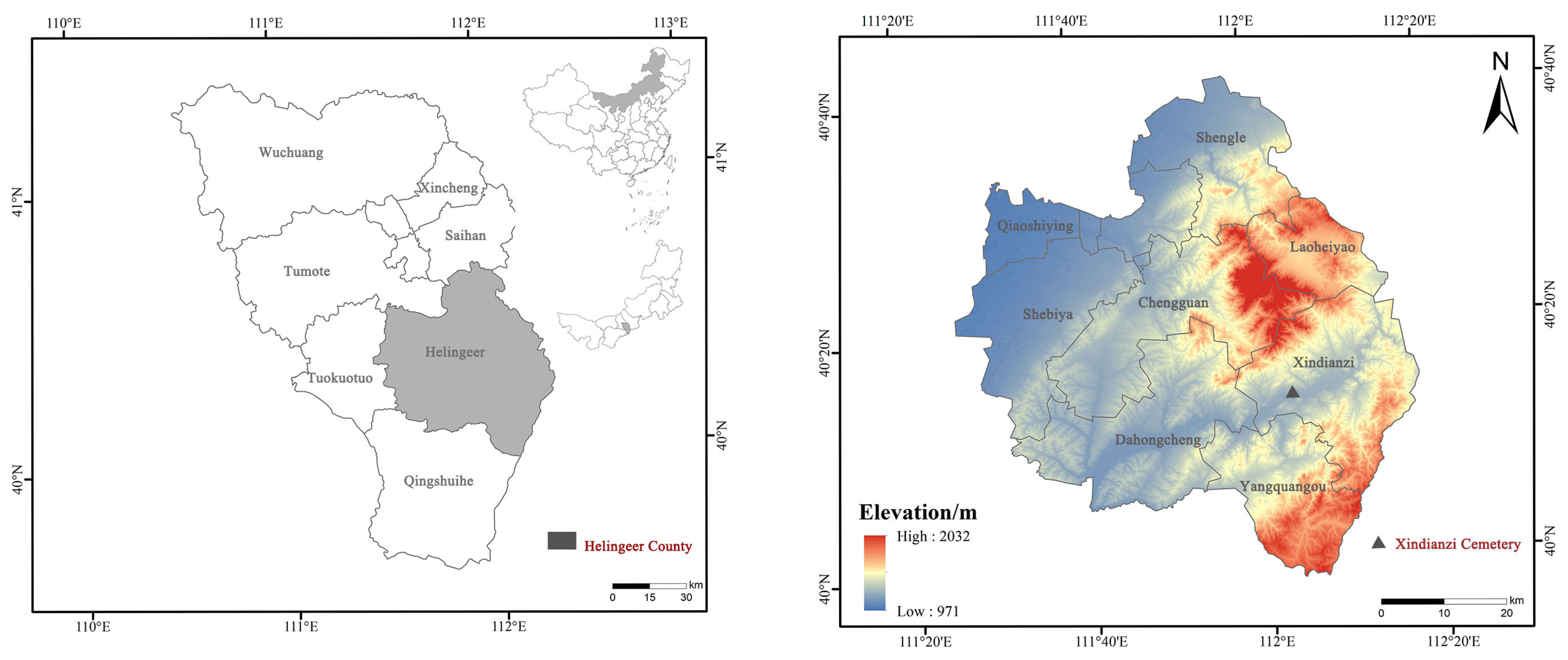
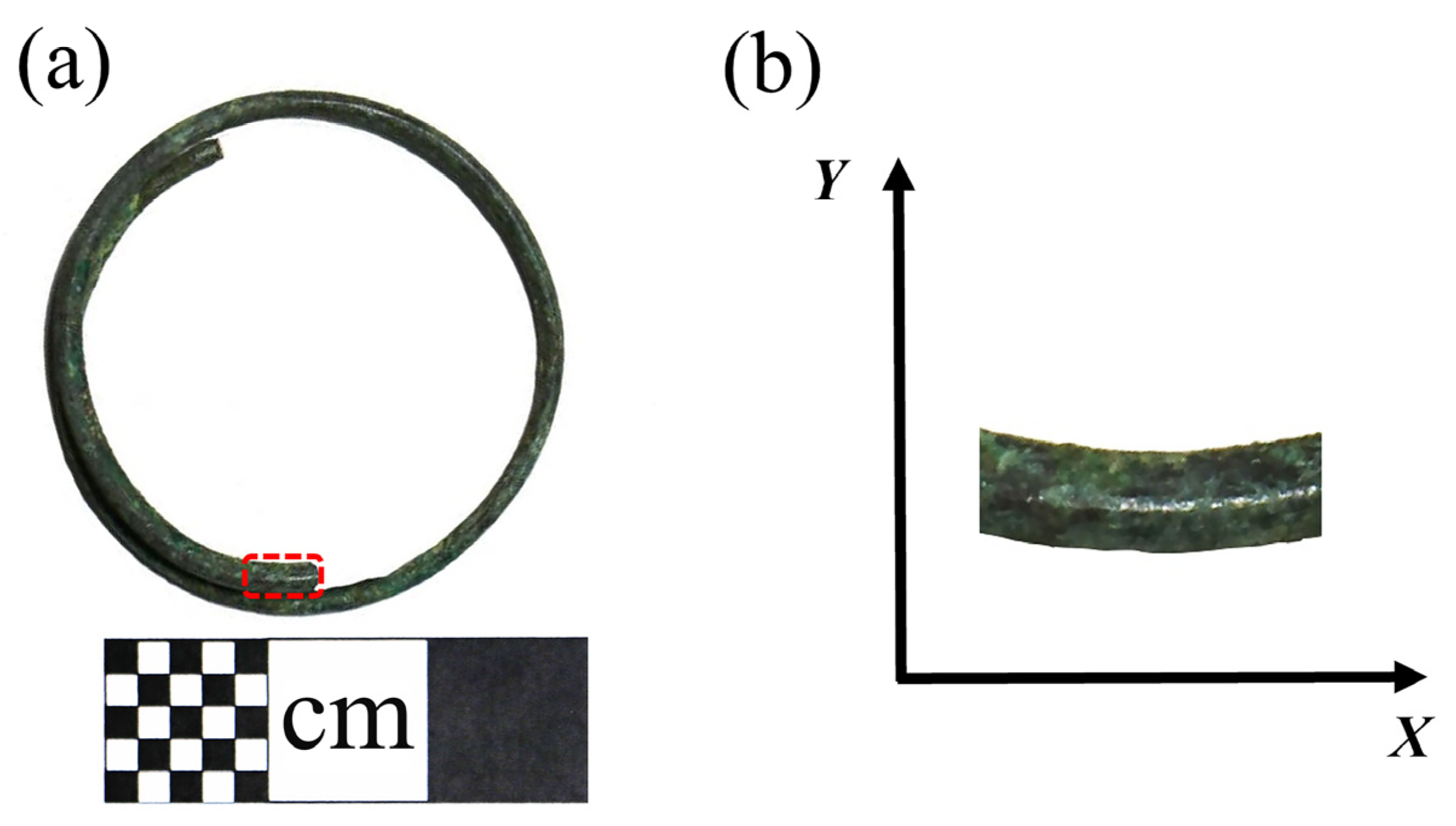
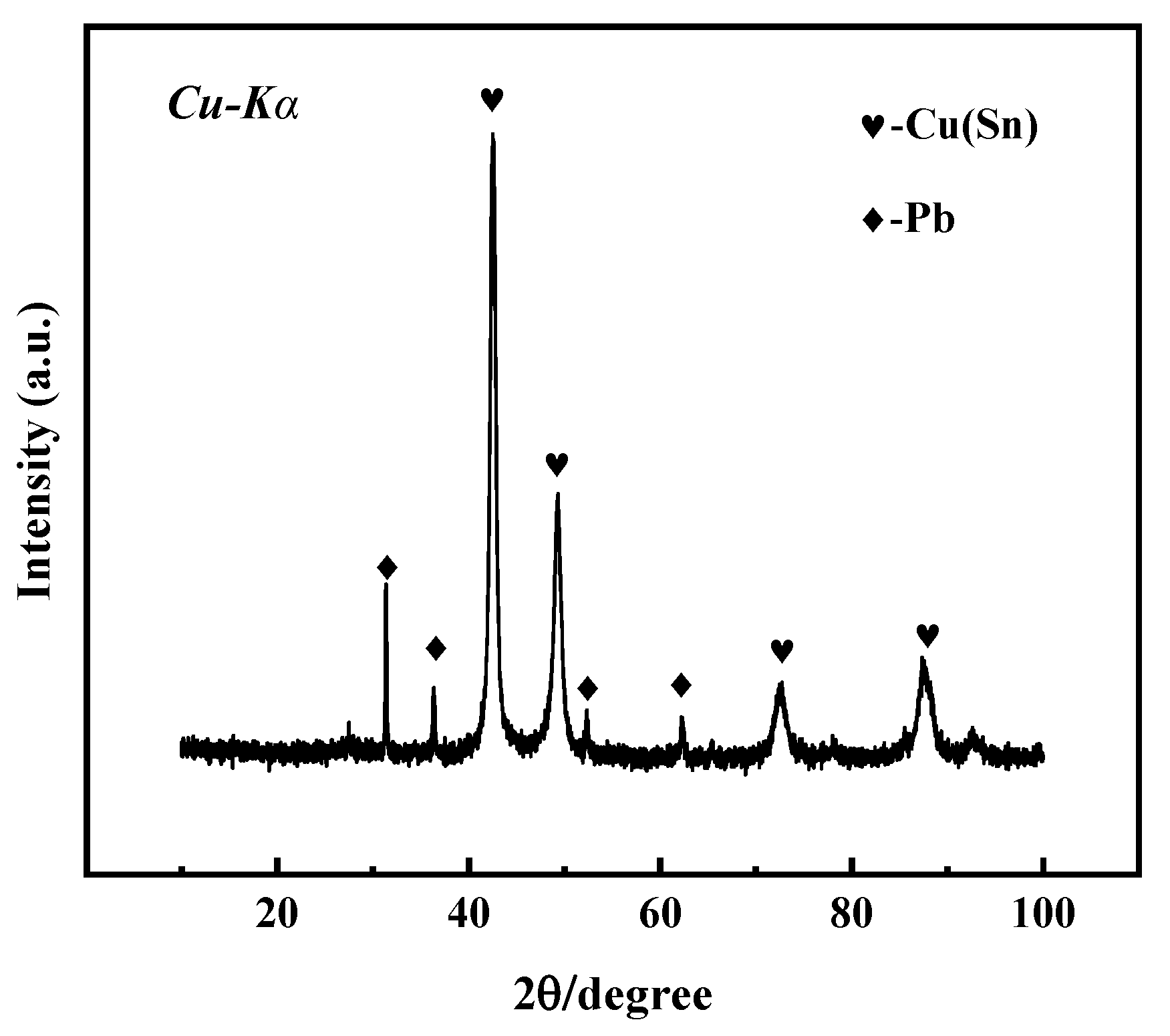
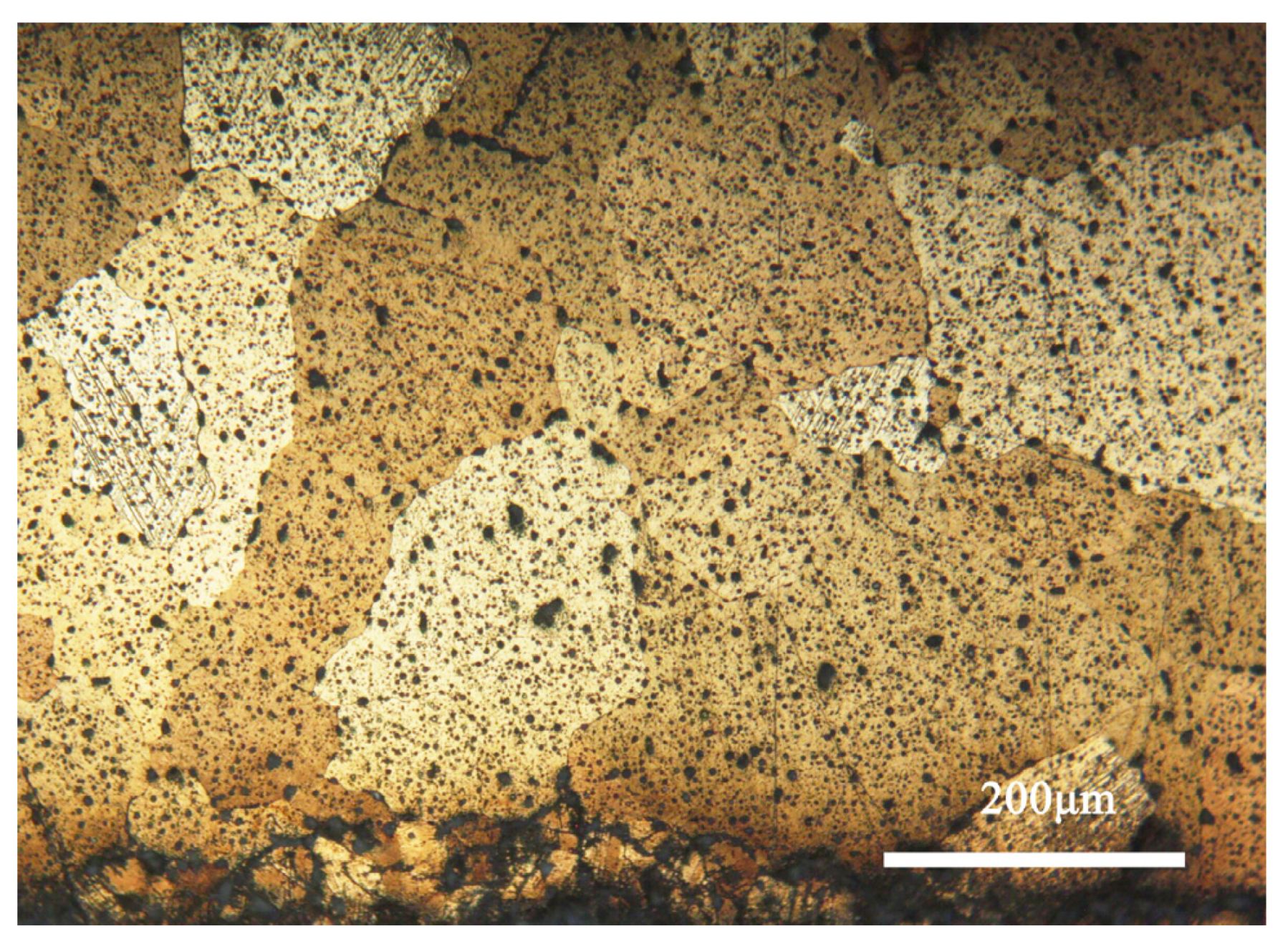




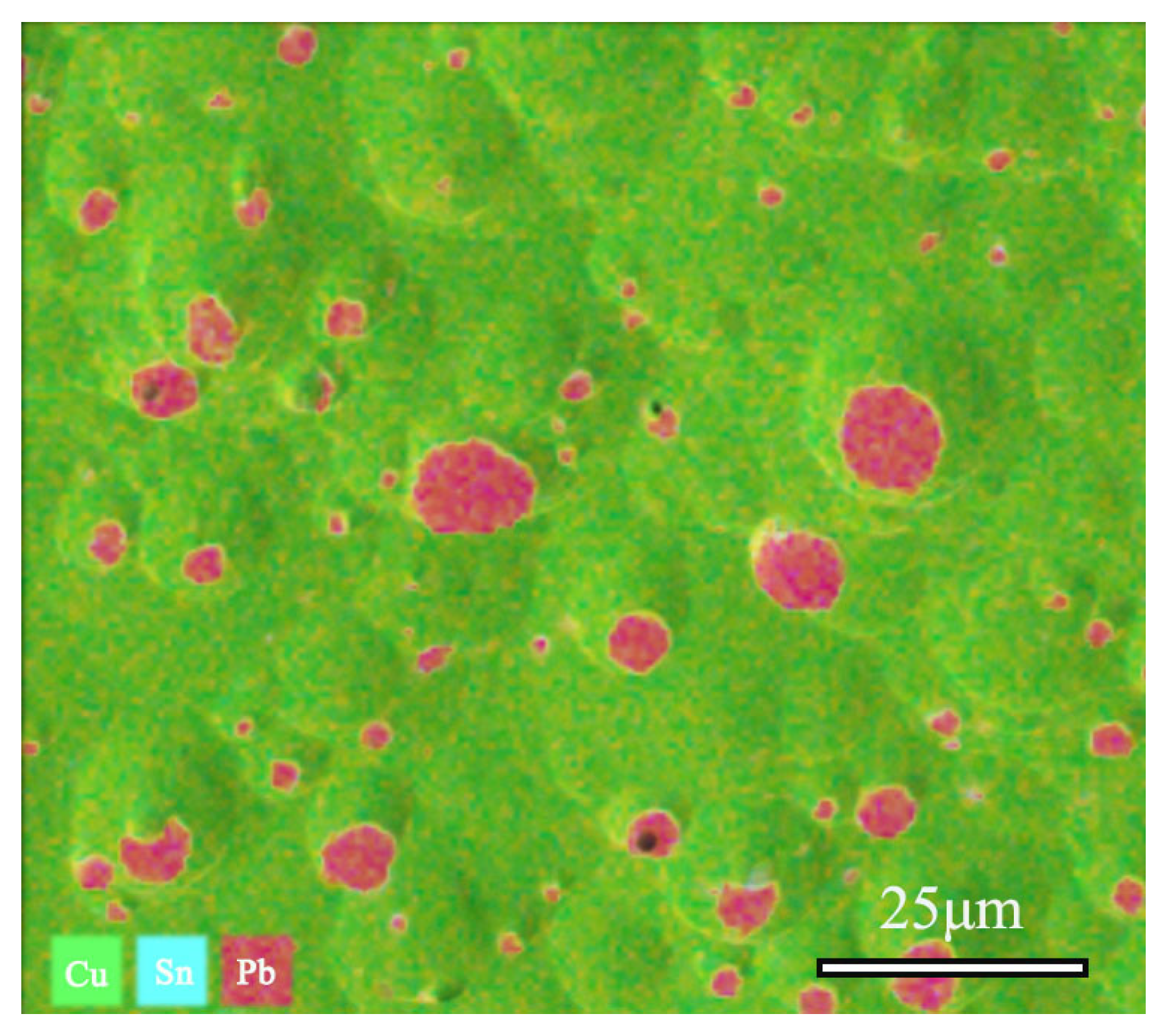
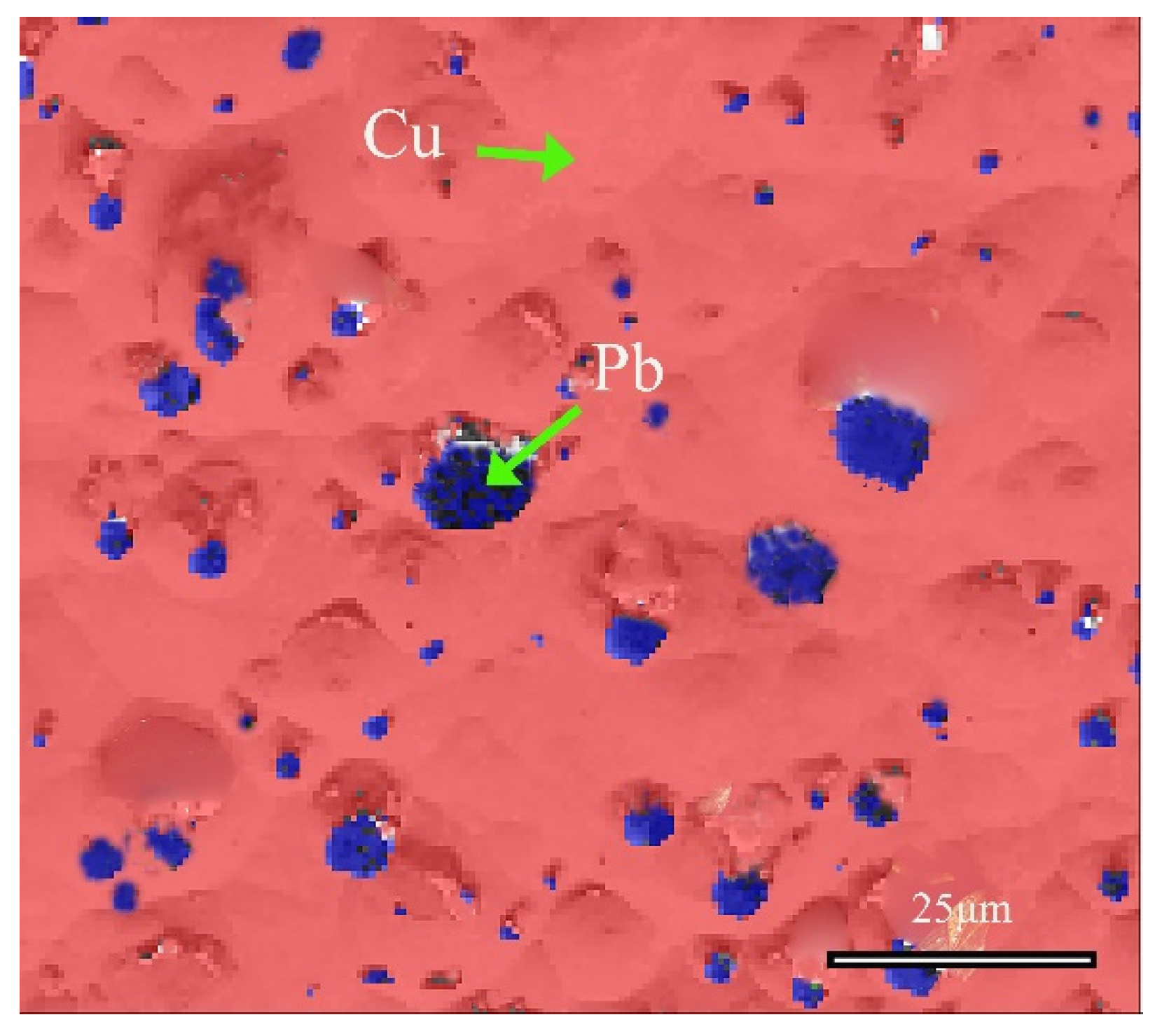

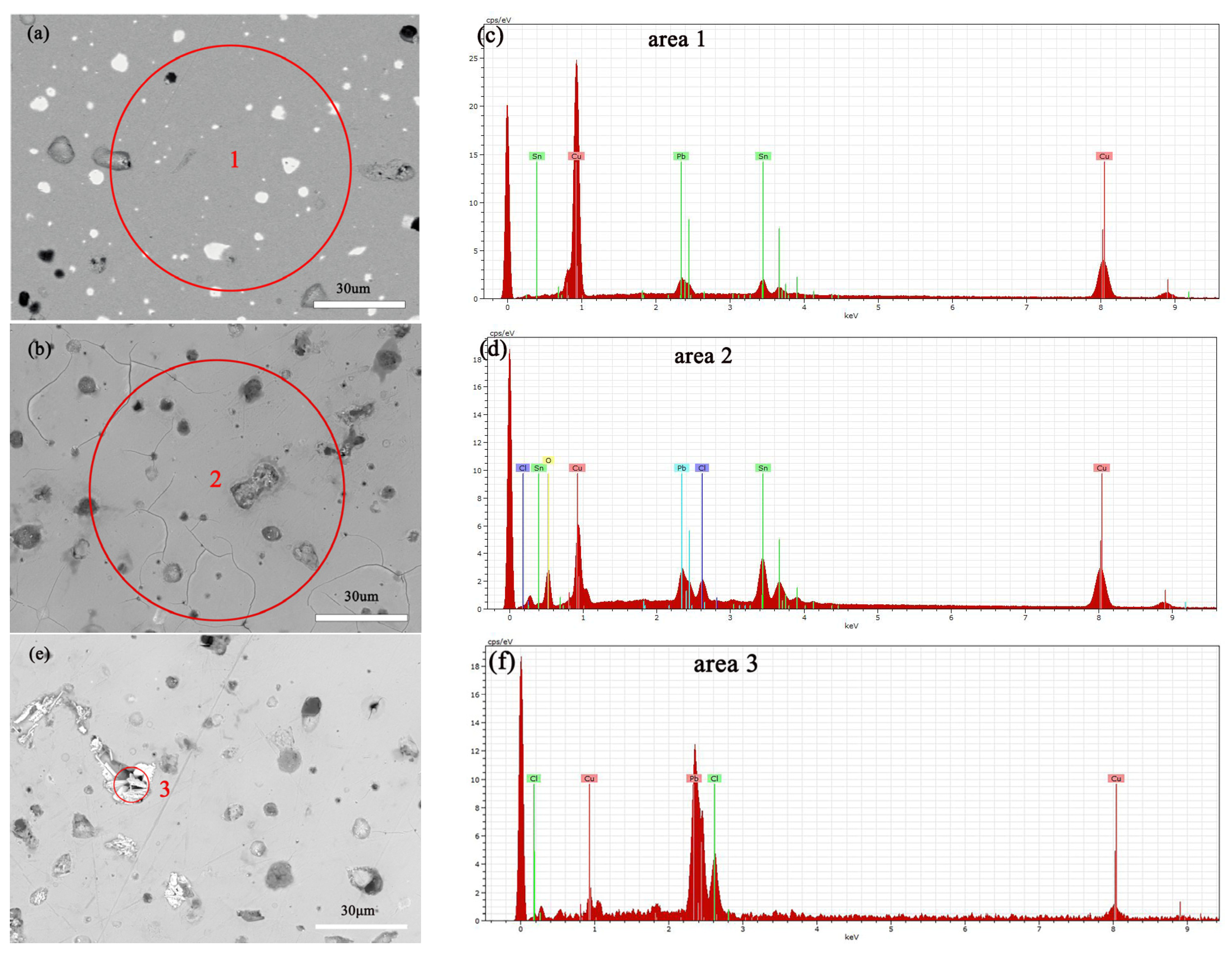
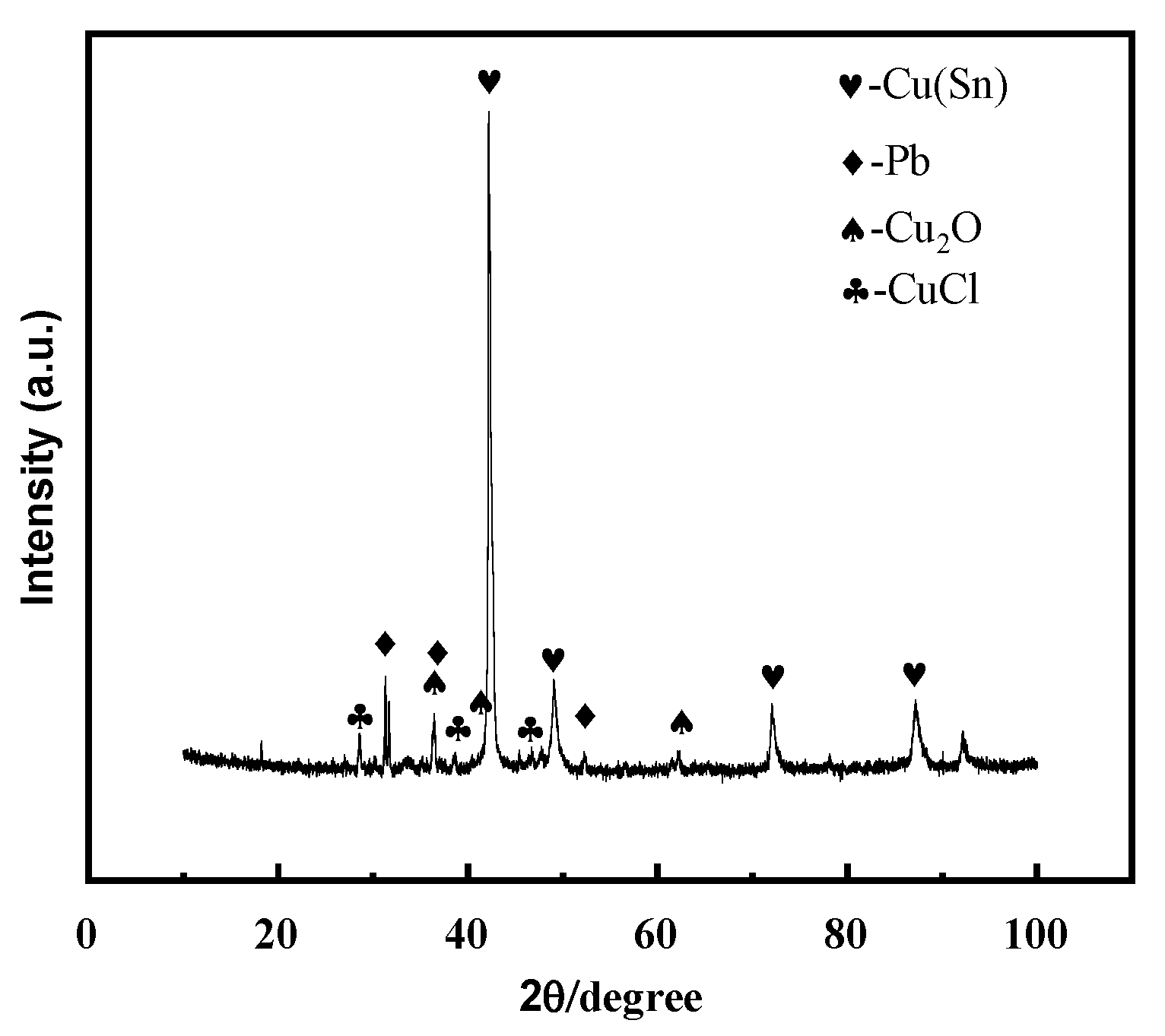
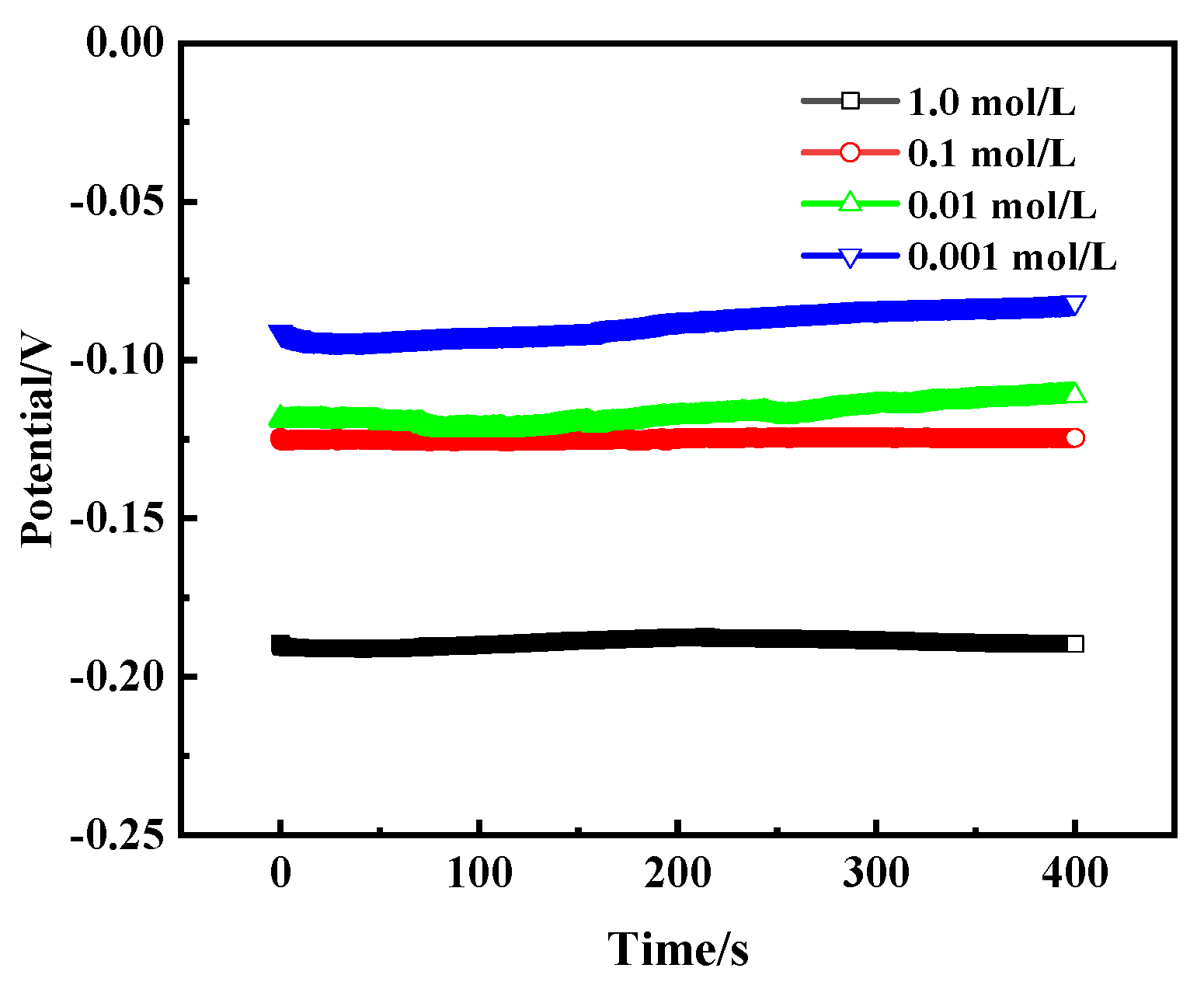




| Position | Sn (wt.%) | Cu (wt.%) | Pb (wt.%) | O (wt.%) | Cl (wt.%) |
|---|---|---|---|---|---|
| Without corrosion | 10.71 | 78.36 | 10.82 | 0.11 | 0 |
| With corrosion | 20.60 | 55.16 | 11.14 | 9.73 | 2.76 |
| Solution | Ecorr/V | Icorr/A·cm2 | Ba/V−1 | Bc/V−1 | Rp/KΩ |
|---|---|---|---|---|---|
| 1 mol/L | −0.196 | 9.051 × 10−7 | 2.155 | 16.3 | 91.432 |
| 10−1 mol/L | −0.172 | 6.204 × 10−7 | 3.353 | 5.816 | 149.044 |
| 10−2 mol/L | −0.145 | 5.795 × 10−7 | 9.626 | 3.948 | 210.041 |
| 10−3 mol/L | −0.130 | 2.372 × 10−7 | 10.519 | 3.776 | 509.386 |
| Solution | Rs/(Ω·cm2) | Qdl/(Ω·cm2) | n | Rct (Ω·cm2) |
|---|---|---|---|---|
| 1 mol/L | 47.200 | 5.0805 × 10−8 | 0.742 | 115,590 |
| 10−1 mol/L | 71.570 | 3.5577 × 10−6 | 0.737 | 123,000 |
| 10−2 mol/L | 3347 | 1.8811 × 10−6 | 0.687 | 230,200 |
| 10−3 mol/L | 3454 | 1.9862 × 10−6 | 0.705 | 319,460 |
Disclaimer/Publisher’s Note: The statements, opinions and data contained in all publications are solely those of the individual author(s) and contributor(s) and not of MDPI and/or the editor(s). MDPI and/or the editor(s) disclaim responsibility for any injury to people or property resulting from any ideas, methods, instructions or products referred to in the content. |
© 2024 by the authors. Licensee MDPI, Basel, Switzerland. This article is an open access article distributed under the terms and conditions of the Creative Commons Attribution (CC BY) license (https://creativecommons.org/licenses/by/4.0/).
Share and Cite
Song, Z.; Tegus, O. Microstructure and Chlorine Ion Corrosion Performance in Bronze Earring Relics. Materials 2024, 17, 1734. https://doi.org/10.3390/ma17081734
Song Z, Tegus O. Microstructure and Chlorine Ion Corrosion Performance in Bronze Earring Relics. Materials. 2024; 17(8):1734. https://doi.org/10.3390/ma17081734
Chicago/Turabian StyleSong, Zhiqiang, and Ojiyed Tegus. 2024. "Microstructure and Chlorine Ion Corrosion Performance in Bronze Earring Relics" Materials 17, no. 8: 1734. https://doi.org/10.3390/ma17081734




